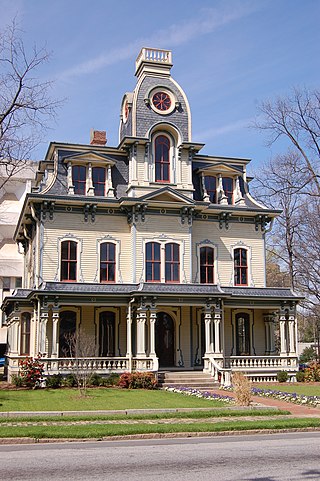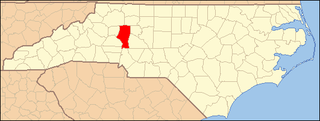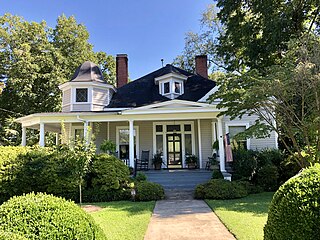
White Oak is a census-designated place (CDP) in Bladen County, North Carolina, United States. The population was 338 at the 2010 census.

This is a list of structures, sites, districts, and objects on the National Register of Historic Places in North Carolina:

The Heck-Andrews House was finished in 1870 and was one of the first houses in Raleigh, Wake County, North Carolina to be constructed after the American Civil War. It is located at 309 North Blount Street. It was created by G.S.H. Appleget for Mrs. Mattie Heck, the wife of Colonel Jonathan McGee Heck. It is on the National Register of Raleigh Historic Property. The house has a dramatic central tower capped with a convex mansard roof with a balustrade. The central part of the 2+1⁄2-story, Second Empire style frame dwelling is enclosed with a concave mansard roof with patterned slate.

Bath Historic District is a historic district in Bath, Beaufort County, North Carolina. The district is now a North Carolina Historic Site belonging to the North Carolina Department of Natural and Cultural Resources and known as Historic Bath, and includes a visitor center offering guided tours of the Bonner House and Palmer-Marsh House, which is also a National Historic Landmark. Visitors can also tour the Van der Veer House and St. Thomas Episcopal Church.

The Thomas Wolfe House, also known as the Thomas Wolfe Memorial, is a state historic site, historic house and museum located at 52 North Market Street in downtown Asheville, North Carolina. The American author Thomas Wolfe (1900–1938) lived in the home during his boyhood. The house was designated a National Historic Landmark in 1971 for its association with Wolfe. It is located in the Downtown Asheville Historic District.

Edenton Historic District is a national historic district located at Edenton, Chowan County, North Carolina. The district encompasses 342 contributing buildings, 4 contributing sites, and 3 contributing structures. It includes several buildings that are individually listed on the National Register. The Lane House, possibly the oldest surviving house in North Carolina, is owned by Steve and Linda Lane and is located within the district. Also located in the district are the Dixon-Powell House, William Leary House, and Louis Ziegler House designed by architect George Franklin Barber.
The Green-Hartsfield House, also known as the Hartsfield House, is a historic home located near Rolesville, Wake County, North Carolina, a satellite town northeast of the state capital Raleigh. Built in 1805, the house is an example of Late Georgian / Early Federal style architecture. It is a two-story, three bay, single pile, frame dwelling sheathed in weatherboard, with a two-story gable-roofed rear ell. A one-story rear shed addition was added in the 1940s. The house was restored between 1985 and 1987. Also on the property is a contributing frame barn.

This list includes properties and districts listed on the National Register of Historic Places in Wake County, North Carolina. Click the "Map of all coordinates" link to the right to view an online map of all properties and districts with latitude and longitude coordinates in the table below.

This list includes properties and districts listed on the National Register of Historic Places in Mecklenburg County, North Carolina. Click the "Map of all coordinates" link to the right to view an online map of all properties and districts with latitude and longitude coordinates in the table below.

This list includes properties and districts listed on the National Register of Historic Places in Iredell County, North Carolina. Click the "Map of all coordinates" link to the right to view an online map of all properties and districts with latitude and longitude coordinates in the table below.

Historic Oakwood is a neighborhood in downtown Raleigh, North Carolina, United States, on the National Register of Historic Places, and known for its Historic Oakwood Cemetery, its many Victorian houses and its location close to the Mordecai Plantation Manor. Located near the State Capitol and St. Augustine's Chapel, during the 19th century Historic Oakwood was home to prominent members of Raleigh's society. It is North Carolina's largest, intact 19th Century residential neighborhood and Raleigh's earliest white middle-class suburb. Unlike later suburbs, it developed lot-by-lot over time, instead of by platted sections. Its Victorian-era architectural styles include Second Empire, Queen Anne, and Italianate. Later infill brought the bungalow, the American Foursquare, American Craftsman style, and the Minimal Traditional house to the area.

This list includes properties and districts listed on the National Register of Historic Places in Wilkes County, North Carolina. Click the "Map of all coordinates" link to the right to view an online map of all properties and districts with latitude and longitude coordinates in the table below.

This list includes properties and districts listed on the National Register of Historic Places in Caswell County, North Carolina. Click the "Map of all coordinates" link to the right to view an online map of all properties and districts with latitude and longitude coordinates in the table below.

This list includes properties and districts listed on the National Register of Historic Places in Robeson County, North Carolina. Click the "Map of all coordinates" link to the right to view a Google map of all properties and districts with latitude and longitude coordinates in the table below.

The House in the Horseshoe, also known as the Alston House, is a historic house in Glendon, North Carolina in Moore County, and a historic site managed by the North Carolina Department of Natural and Cultural Resources' Historic Sites division. The home, built in 1772 by Philip Alston, was the site of a battle between loyalists under the command of David Fanning and patriot militiamen under Alston's command on either July 29 or August 5, 1781. The battle ended with Alston's surrender to Fanning, in which Alston's wife negotiated the terms with the loyalists.

Halifax Historic District is a national historic district located at Halifax, Halifax County, North Carolina, US that was listed on the National Register of Historic Places in 1970. It includes several buildings that are individually listed on the National Register. Halifax was the site of the signing of the Halifax Resolves on April 12, 1776, a set of resolutions of the North Carolina Provincial Congress which led to the United States Declaration of Independence gaining the support of North Carolina's delegates to the Second Continental Congress in that year.

John Alexander Lackey House is a historic home located at Morganton, Burke County, North Carolina. It was built about 1900, and is a two-story, "T"-shaped, gable roofed, brick farmhouse. It has a one-story, gabled kitchen wing. The house features Colonial Revival style detailing.

West Union Street Historic District is a national historic district located at Morganton, Burke County, North Carolina. It encompasses 59 contributing buildings in a predominantly upper class residential section of Morganton. They were built between about 1815 and 1940, with the majority built between about 1890 and 1938. The district includes representative examples of Queen Anne, Colonial Revival, Bungalow / American Craftsman, and Late Victorian style architecture. Located in the district and listed separately is the Franklin Pierce Tate House.

Morganton Downtown Historic District is a national historic district located at Morganton, Burke County, North Carolina. It encompasses 62 contributing buildings in the central business district of Morganton. It includes commercial, industrial, and governmental buildings built between about 1889 and 1940. It includes representative examples of Classical Revival, Art Deco, and Italianate style architecture. Notable buildings include the Old Burke County Courthouse, Morganton Post Office, and the Morganton Community House.

North Green Street–Bouchelle Street Historic District is a national historic district located at Morganton, Burke County, North Carolina. It encompasses 37 contributing buildings in a predominantly residential section of Morganton. It includes buildings built between about 1876 and 1935, and includes representative examples of Colonial Revival, Bungalow / American Craftsman, and Late Victorian style architecture. Located in the district is the separately listed Alphonse Calhoun Avery House.






















